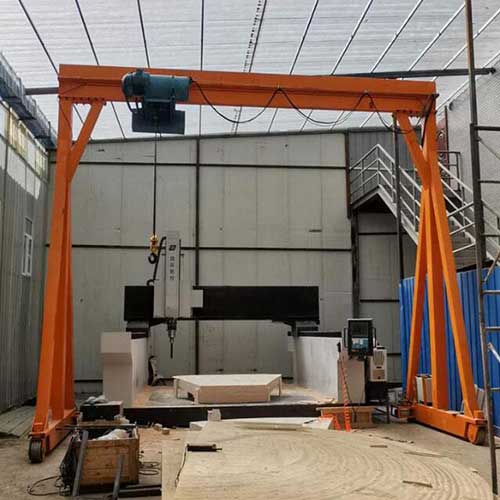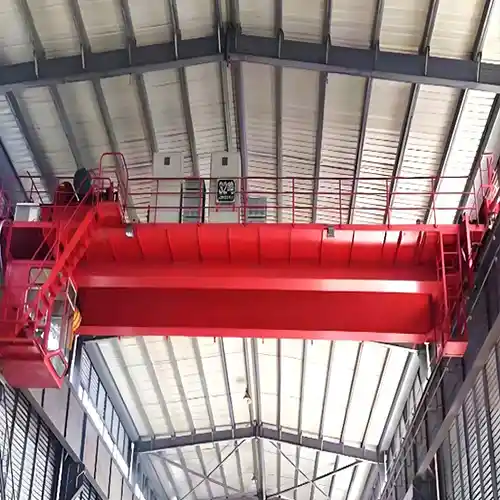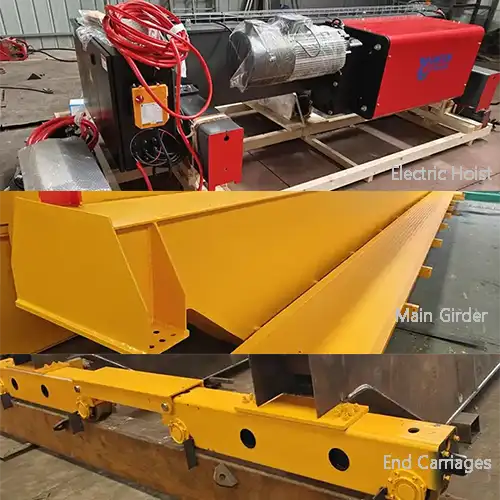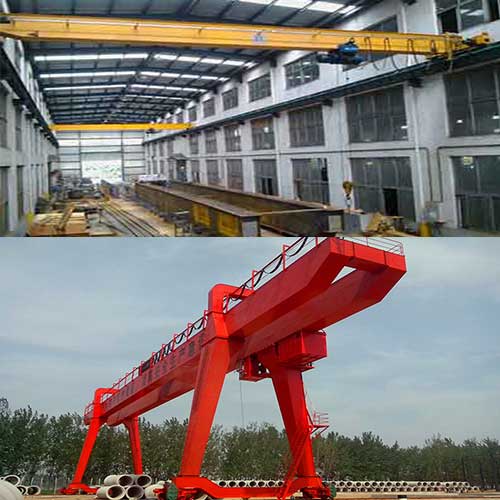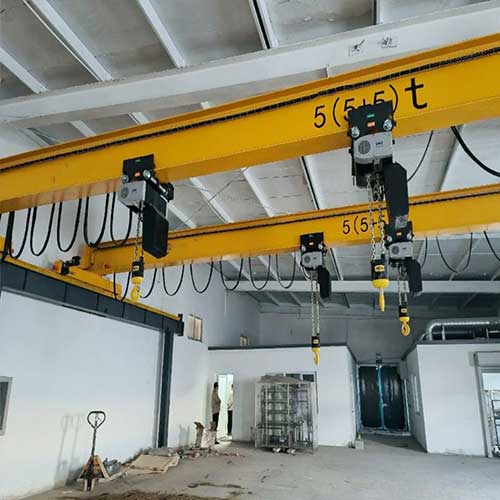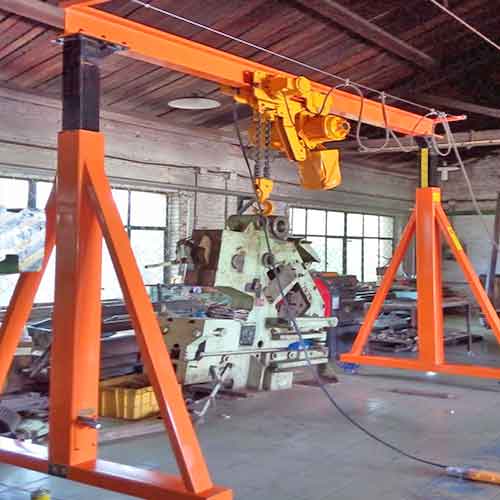Small Indoor Crane: Small Overhead, Gantry,Jib & Portable Crane
Small Indoor Crane for sale 0.5-10 ton. Custom indoor crane system,small overhead crane, portable gantry crane, small jib & portable jib crane, good price.
| Small indoor steel gantry | 0.25- 10 ton |
| Small alum indoor gantry | 0.25- 5 ton |
| Small jib crane | 0.25- 5 ton |
Category: Indoor Crane
Your Trusted Indoor Crane Manufacturer & Supplier
Small Indoor Crane: Small Overhead, Gantry,Jib & Portable Crane
Small Indoor Crane for sale 0.5-10 ton. Custom indoor crane system,small overhead crane, portable gantry crane, small jib & portable jib crane, good price.
In the ever-evolving landscape of modern industry, the role of small indoor cranes has become increasingly significant. These compact and versatile material handling solutions have revolutionized the way businesses operate within confined indoor spaces. In this article, we will explore the world of small indoor cranes, shedding light on their importance, features, applications, and the benefits they bring to industries. We'll also delve into the integration of small indoor cranes within comprehensive indoor crane systems, highlighting real-world examples and safety practices that underscore their essential place in the industrial realm.
Small Indoor Crane Defined:
Small indoor cranes, as the name suggests, are specialized lifting and material handling devices designed for use within indoor facilities where space is at a premium. These cranes are known for their compact form factor and ability to operate with precision in confined environments. They play a pivotal role in optimizing material handling processes while adhering to safety and efficiency standards.
Key Terms: Small Indoor Crane, Mobile Indoor Crane, Portable & Mobile Cranes, Indoor Crane System
Before we embark on this journey into the realm of small indoor cranes, it's crucial to familiarize ourselves with key terminology that will repeatedly surface throughout this exploration. These terms include "small indoor crane," "mobile indoor crane," "portable & mobile cranes," and "indoor crane system." Each term embodies a unique aspect of the world of indoor cranes, representing their adaptability, portability, and comprehensive integration into industrial operations. These terms form the cornerstones of the small indoor crane domain, providing a robust framework for enhancing efficiency and safety within indoor industrial settings.
Key Features of Small Indoor Cranes
Small indoor cranes are packed with features that make them indispensable tools in modern industry. Their unique design and capabilities cater to the demands of confined indoor spaces. Let's explore the key features that set small indoor cranes apart:
- Compact Design for Confined Spaces: Small indoor cranes are expertly engineered to thrive in tight and narrow environments. Their compact design allows them to operate seamlessly in spaces where traditional, bulkier cranes would struggle to function effectively. Whether it's a manufacturing plant with closely packed assembly lines or a cluttered warehouse filled with towering shelves, small indoor cranes excel in navigating these spatial challenges.
- Precise Load Handling and Maneuverability: These cranes are renowned for their precision in load handling. Whether it's lifting delicate laboratory equipment in a research facility or positioning heavy machinery components in a manufacturing unit, small indoor cranes offer the finesse needed for intricate operations. Their maneuverability ensures that operators can place loads with pinpoint accuracy, reducing the margin of error in material handling.
- User-Friendly Controls for Ease of Operation: Small indoor cranes are designed with user-friendliness in mind. Operators, whether seasoned professionals or newcomers to the industry, find these cranes easy to control. They often come equipped with intuitive control systems, which can include joysticks, buttons, or remote controls. This simplicity in operation translates to shorter learning curves and increased operational efficiency.
- Mobility and Portability for Versatile Use: One of the standout features of small indoor cranes is their mobility and portability. These cranes are not bound to a single location; they can be easily moved to various spots within a facility. Some models are equipped with wheels or casters, while others can be dismantled and reassembled in a different location. This versatility allows small indoor cranes to adapt to the changing needs of different indoor environments.
In a world where space is at a premium, small indoor cranes are the embodiment of adaptability and efficiency. Their compact design, precision, user-friendliness, and mobility make them indispensable assets in a wide range of industries. Whether you're in manufacturing, warehousing, construction, or research, small indoor cranes are engineered to optimize material handling processes and enhance the overall productivity of indoor operations.
Types of Small Indoor Cranes
Small indoor cranes come in a variety of types, each tailored to specific tasks and spatial requirements. Here, we'll explore five common types of small indoor cranes that have found their niche in industries where space is a premium:
Portable Gantry Cranes:
Portable gantry cranes are versatile, freestanding cranes supported by two upright beams and equipped with wheels for mobility. They can be easily moved to different locations within an indoor facility. These cranes are well-suited for tasks like loading/unloading, assembly, and maintenance. Portable gantry cranes provide both lateral and vertical lifting capabilities, making them adaptable for a wide range of applications.
There are several main types of small gantry cranes designed for indoor use, each with its unique features and benefits. Here's an overview of the main types and their typical applications, features, and benefits:

Fixed Height Small Indoor Gantry Cranes:
Features:
- Fixed height small gantry cranes have a stable and unadjustable vertical clearance.
- They are often mounted on a fixed base, providing robust support.
Benefits:
- Simplicity: These cranes are easy to set up and require minimal maintenance.
- Cost-Effective: Fixed height gantry cranes are often more budget-friendly than adjustable models.
Typical Applications:
- Loading and unloading heavy materials in manufacturing facilities.
- Maintenance tasks in industrial settings where a stable clearance is sufficient.
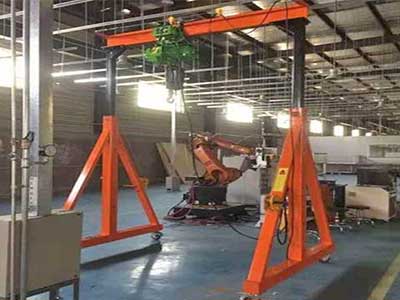
Adjustable Height Small Indoor Gantry Cranes:
Features:
- Adjustable height gantry cranes allow the vertical clearance to be customized.
- They come with telescoping or adjustable legs to accommodate varying heights.
Benefits:
- Versatility: The ability to adjust the height makes them suitable for a wide range of applications.
- Flexibility: Adjustable gantry cranes can adapt to different load and workspace requirements.
Typical Applications:
- Warehousing for various heights of storage and material handling.
- Manufacturing processes where products or equipment have varying heights.

Features:
- Aluminum gantry cranes are lightweight and highly portable.
- They are corrosion-resistant, making them ideal for indoor settings.
Benefits:
- Portability: Aluminum gantry cranes are easy to move and transport.
- Corrosion Resistance: They are suitable for environments where corrosion is a concern.
Typical Applications:
- Laboratories and cleanroom environments for precise material handling.
- Indoor settings where portability and corrosion resistance are crucial.
The choice of small indoor gantry crane type depends on the specific needs of your indoor facility. Small gantry cranes, in general, offer the following benefits:
- Space Optimization: They are designed to operate in confined indoor spaces, optimizing floor space.
- Precise Load Handling: These cranes provide accurate load positioning and control.
- Mobility: Many small gantry cranes are portable, allowing them to be easily relocated within a facility.
- Versatility: They can adapt to various tasks and industries, ensuring that they remain cost-effective solutions for indoor material handling.
Small indoor gantry cranes are invaluable tools in industries such as manufacturing, warehousing, and maintenance, where efficient and precise material handling is essential. Their adaptability and versatility make them suitable for a wide range of indoor applications, improving operational efficiency and safety.
Jib Cranes:
Jib cranes are compact, floor-mounted or wall-mounted cranes with a horizontal boom that can rotate up to 360 degrees. Their design allows for precise load handling and placement in confined spaces, making them ideal for tasks that require maneuverability and access to hard-to-reach areas. Jib cranes are commonly used in maintenance, manufacturing, and laboratories for tasks like equipment repair and material handling.

A floor jib crane is a material handling device that is securely mounted to the floor using a large base plate. It is known for its 360-degree rotation capability, allowing it to swivel in a complete circle. This type of crane is a versatile tool, commonly used in manufacturing and assembly processes. Its high mobility and flexibility make it well-suited for tasks such as positioning heavy components during product assembly and efficiently loading and unloading materials from machinery or storage. Floor jib cranes provide an optimal solution for applications where the ability to move heavy loads in a circular radius and serve multiple workstations within their rotation range is essential.

In contrast, a wall jib crane is designed to be attached to a wall or vertical surface rather than being anchored to the floor. Wall jib cranes typically offer a 180-degree rotation range, allowing them to handle loads along a semi-circular path. These cranes excel at providing targeted load handling along a specific line or wall. They are frequently employed for material transfer within a confined space, and they are particularly suitable for machine feeding, enabling materials to be efficiently fed into machines or equipment along the path of their rotation. Wall jib cranes are valued for their space efficiency, making them ideal for facilities with limited floor space and a need for focused load handling in a linear path.
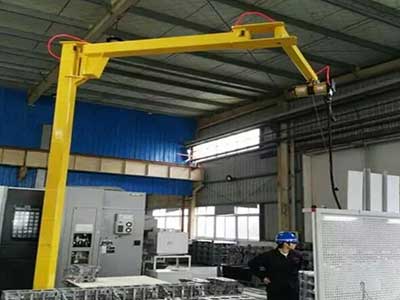
Articulating Jib Cranes:
Articulating jib cranes are a variation of the traditional jib crane. They feature a multi-sectioned arm that can articulate to reach into tight spaces and around obstacles. These cranes are valuable in applications where access is limited, and precise load handling is crucial. They are especially useful for maintenance tasks in confined areas, providing the flexibility needed for efficient equipment repair.
Floor Jib Crane and Wall Jib Crane: A Comparison
Jib cranes are essential material handling tools that come in various configurations to meet specific operational needs. Two common variations of jib cranes are floor jib cranes and wall jib cranes. Let's compare these two types to understand their differences and applications:
Here's a comparison of floor jib cranes and wall jib cranes presented in a table format:
| Feature | Floor Jib Crane | Wall Jib Crane |
|---|---|---|
| Mounting Location | Mounts on the floor | Attached to a wall |
| Rotation Range | 360-Degree Rotation | 180-Degree Rotation |
| Common Applications | - Assembly Lines | - Material Transfer |
| - Loading/Unloading | - Machine Feeding | |
| - Versatile in various tasks | - Focused load handling | |
| Benefits | - High Mobility | - Space Efficiency |
| - Versatility | - Focused Load Handling |
This table provides a clear overview of the key differences between floor jib cranes and wall jib cranes, helping you understand their distinct features and applications.
Floor Jib Crane:
- Mounting Location:- Mounts on the floor:As the name suggests, a floor jib crane is secured directly to the ground, typically through a large base plate that provides stability.
- Rotation Range:- 360-Degree Rotation:Floor jib cranes are designed to swivel a full 360 degrees, allowing for unrestricted load placement anywhere within their circular coverage area.
- Common Applications:- Assembly Lines:Floor jib cranes are often used in manufacturing and assembly processes for tasks like positioning heavy components during product assembly.
- Loading/Unloading:They are valuable for efficiently loading and unloading materials from machinery or storage.
- Benefits:- High Mobility:Their mobility allows for the flexibility to move heavy loads in a circular radius. - Versatility:Floor jib cranes can serve multiple workstations within their rotation range.
Wall Jib Crane:
- Mounting Location:- Attached to a Wall:Wall jib cranes are mounted to a wall or vertical surface. They do not require a floor base, which frees up floor space.
- Rotation Range:- 180-Degree Rotation:Wall jib cranes typically offer a 180-degree rotation range. This means they can handle loads along a semi-circular path.
- Common Applications:- Material Transfer:Wall jib cranes are often used for transferring materials from one location to another, particularly along a wall or in a linear path.
- Machine Feeding:They can be employed for feeding materials into machines or equipment along the path of their rotation.
- Benefits:- Space Efficiency:Wall jib cranes are ideal for facilities with limited floor space, as they are wall-mounted and don't occupy ground space. - Focused Load Handling:They excel at providing targeted load handling along a specific line or wall.
In summary, floor jib cranes offer complete 360-degree rotation and are typically used in manufacturing and assembly settings where versatility and mobility are key. Wall jib cranes, on the other hand, offer a 180-degree rotation and are commonly employed for material transfer and machine feeding, emphasizing space efficiency and focused load handling. The choice between these two jib crane types depends on the specific needs of your operation and the spatial constraints of your facility.
Overhead Cranes:
Overhead cranes are ceiling-mounted cranes with a trolley system that travels along an I-beam or enclosed track. They optimize floor space by operating above the workspace. These cranes are known for their smooth and efficient load movement, making them suitable for lifting and positioning heavy loads in manufacturing and production facilities. They are especially beneficial when space is limited, as they keep the floor area unobstructed.
What are the main types of small overhead cranes for indoor uses ? What are the features, benefits, and typical applications of the small overhead cranes?
Small overhead cranes for indoor use come in several main types, each tailored to specific applications. Here's an overview of these types and their features, benefits, and typical applications:
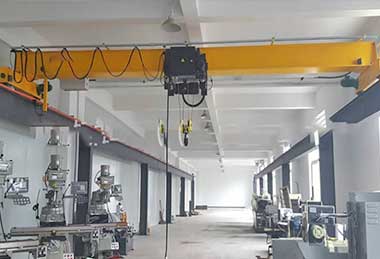
Top-Running Small Indoor Overhead Cranes:
Features:
- Top-running overhead cranes travel along rails or beams mounted on the ceiling.
- They are suitable for lifting and transporting heavy loads.
Benefits:
- Efficient Use of Space: Top-running cranes make the most of available headroom, allowing for unobstructed floor space.
- Precise Load Handling: They offer accurate load positioning and control.
Typical Applications:
- Manufacturing facilities for lifting machinery and equipment.
- Warehouses with tall storage racks for efficient material handling.
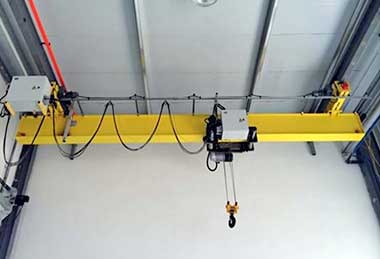
Under-Running (Underhung) Indoor Small Overhead Cranes:
Features:
- Under-running overhead cranes run on rails or beams attached to the building structure, typically under the ceiling.
- They are ideal for installations with limited headroom.
Benefits:
- Compact Design: Under-running cranes are suitable for low-ceiling environments where top-running models may not fit.
- Versatility: They can adapt to a range of indoor settings and layouts.
Typical Applications:
- Low-ceiling manufacturing facilities and workshops.
- Small-scale warehousing and material handling in confined spaces.
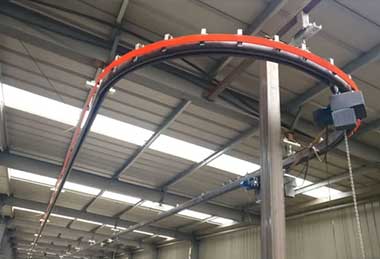
Features:
- Monorail overhead cranes consist of a single beam and a trolley that moves along it.
- They are designed for linear, point-to-point material handling.
Benefits:
- Precision: Monorail cranes are excellent for precise load transportation along a fixed path.
- Space Optimization: They are efficient in situations where floor space is limited.
Typical Applications:
- Assembly lines where components are moved along a fixed path.
- Cleanroom and laboratory environments for controlled material handling.
- Small overhead cranes, in general, offer the following features and benefits:
- Space Optimization: They make efficient use of vertical space, leaving the floor area unobstructed.
- Precise Load Handling: Overhead cranes provide accurate positioning and control.
- Enhanced Safety: They minimize the risk of collisions and accidents that may occur with floor-based material handling methods.
- Versatility: Overhead cranes can adapt to various indoor tasks and industries, ensuring operational efficiency and safety.
The choice of the small overhead crane type depends on the specific requirements of your indoor facility, including the available space, load capacity, and the nature of your material handling tasks.
Show me the similarity and difference of different types of small overhead cranes? In bullet form and table
Each of these small indoor crane types serves a specific purpose and offers unique advantages. By selecting the appropriate type for your indoor facility, you can enhance material handling efficiency, optimize space, and ensure that your operations run smoothly, even within the constraints of limited indoor space.
| Feature | Single Girder Overhead Crane | Double Girder Overhead Crane | Top-Running Overhead Crane | Under-Running Overhead Crane | Monorail Overhead Crane |
|---|---|---|---|---|---|
| Horizontal Beams | Single beam | Two beams | Single / Double / More | Single / Double Girder | Single beam/ Straight / Curved |
| Load Capacity | Light to moderate | Heavy-duty | Heavy-duty | Light | Light to Moderate |
| Installation | Ceiling-mounted | Ceiling-mounted | Ceiling-mounted | Attached under ceiling | Ceiling-mounted |
| Space Efficiency | Space-efficient | Space-efficient | Efficient use of space | Compact design | Efficient use of space |
This table provides a clear comparison of the main types of small overhead cranes, highlighting their respective features, benefits, and differences. The choice of the right crane type depends on your specific application needs and facility constraints.
Benefits of Small Indoor Cranes
Small indoor cranes offer a range of advantages, making them valuable assets in industrial and indoor settings. Here are some key benefits of using these compact material handling solutions:
Space Optimization and Floor Space Savings:
- Small indoor cranes are designed to make the most of limited indoor space. They operate vertically, leaving the floor area unobstructed.
- They are ideal for crowded manufacturing facilities, warehouses with tall storage racks, and workshops with minimal space.
Increased Productivity in Tight Spaces:
- Small indoor cranes enhance productivity in confined areas where maneuverability is a challenge. They can access tight corners and narrow spaces with ease.
- These cranes provide precise load handling, reducing the time and effort required to complete tasks efficiently.
Cost-Effectiveness Compared to Fixed Crane Systems:
- Small indoor cranes are cost-effective alternatives to fixed, large-scale crane systems. They are often more budget-friendly in terms of initial investment, installation, and maintenance.
- Their adaptability allows businesses to meet material handling needs without the high costs associated with installing permanent crane systems.
Enhanced Safety Features for Indoor Use:
- Small indoor cranes are equipped with safety features that ensure secure and efficient material handling. These features may include overload protection, emergency stop buttons, and safety interlocks.
- Their precise load control and limited reach reduce the risk of accidents and damage to products and equipment.
Small indoor cranes are invaluable tools in various industries, allowing businesses to optimize their workspace, improve productivity, and enhance safety. Whether it's in manufacturing, warehousing, construction, or maintenance, these cranes provide a cost-effective and efficient solution for indoor material handling needs.
Applications of Small Indoor Cranes
Small indoor cranes find diverse applications across various industries, contributing to efficiency, safety, and productivity within confined indoor environments. Here are some key applications of these versatile material handling solutions:
Manufacturing: Efficient Assembly and Material Handling:
- Small indoor cranes play a crucial role in manufacturing facilities by facilitating efficient assembly processes. They assist in positioning and joining components during the assembly of products.
- These cranes are ideal for lifting and transporting materials to different workstations, optimizing the production line's efficiency.
Warehousing: Space-Efficient Inventory Management:
- In warehouses with limited space, small indoor cranes are essential for effective inventory management. They help in moving goods to and from storage racks and optimizing space utilization.
- The precision and maneuverability of these cranes aid in safe and efficient storage and retrieval of products.
Construction: Precise Lifting and Positioning of Materials:
- Small indoor cranes are valuable tools in construction, where confined spaces and precision are often essential. They assist in lifting and positioning heavy construction materials, such as steel beams and concrete blocks.
- Their maneuverability enables precise placement of materials in challenging construction environments.
Maintenance: Safe Equipment Repair in Confined Spaces:
- Maintenance tasks in industrial facilities often require access to tight and confined spaces. Small indoor cranes, especially jib cranes, provide the necessary flexibility to reach and repair equipment.
- They ensure the safe handling of tools, components, and machinery during maintenance and repair procedures.
In these diverse applications, small indoor cranes optimize material handling processes, minimize downtime, and contribute to the overall efficiency of operations. Whether in manufacturing, warehousing, construction, or maintenance environments, these cranes enhance safety and productivity within indoor settings.
Indoor Crane Systems with Small Cranes
The integration of small indoor cranes into comprehensive indoor crane systems is a strategic approach that offers several advantages. These systems combine the benefits of small cranes with rails and components, significantly enhancing safety and operational efficiency within indoor environments. Here's an overview of the integration, benefits, and enhanced safety of indoor crane systems with small cranes:
Integration of Small Indoor Cranes:
- Indoor crane systems are designed to accommodate small cranes, such as jib cranes, gantry cranes, and overhead cranes. These systems can be customized to fit the specific requirements of the indoor facility.
- Small indoor cranes are mounted on rails, tracks, or suspended from overhead structures, allowing for smooth and controlled movement throughout the workspace.
Benefits of Combining Small Cranes with Rails and Components:
- Small cranes integrated into indoor crane systems provide flexibility and precision. They enable the handling of loads with accuracy, reducing the risk of accidents and damage.
- The rail-mounted or overhead design of these systems optimizes floor space, ensuring unobstructed movement and improved spatial organization.
How Indoor Crane Systems Enhance Safety and Operational Efficiency:
- Indoor crane systems equipped with small cranes enhance safety by reducing manual lifting and minimizing the need for heavy machinery movement in crowded areas.
- The controlled movement of cranes on rails ensures that loads are transported smoothly, reducing the risk of load swings and potential collisions.
- These systems improve operational efficiency by streamlining material handling processes. Small cranes can be easily positioned for different tasks, minimizing downtime.
- They enhance ergonomics by reducing the physical strain on workers, contributing to a healthier and safer work environment.
Indoor crane systems with small cranes are an ideal solution for industries where space is a premium and safety is paramount. By integrating small cranes with rail-based or overhead systems, businesses can optimize their operations, streamline material handling, and enhance overall efficiency, making the workplace safer and more productive.
Factors to Consider When Choosing a Small Indoor Crane
When selecting a small indoor crane, it's essential to consider various factors to ensure it meets your operational needs and maintains a safe work environment. Below are key factors to evaluate during the selection process.
Load Capacity and Weight Limitations
Assessing Typical Loads
Before purchasing a small indoor crane, it's vital to assess the typical loads you will be lifting. Understanding the weight and dimensions of the items you need to handle helps determine the appropriate crane specifications. Consider not only the maximum weight but also the size and shape of the loads, as these factors can affect lifting and maneuvering capabilities.
Importance of Knowing Capacity Limits
Every crane has a defined load capacity, and exceeding this limit can lead to dangerous situations, including equipment failure or accidents. Knowing the capacity limits ensures you choose a crane that can safely handle your heaviest loads without compromising safety or performance. It's advisable to select a crane with a load capacity that exceeds your maximum expected weight to account for unexpected fluctuations.
Space Constraints
Measuring Available Installation Space
Space is often a limiting factor in choosing a small indoor crane. Before making a decision, carefully measure the available installation area, including ceiling height, floor space, and any potential obstructions. This information is critical for determining the type of crane that will fit comfortably in your workspace without hindering operations.
Designing for Optimal Operation
Once you have measured your available space, consider how to design the crane system for optimal operation. This includes selecting the right crane configuration (e.g., overhead, gantry, or jib) and ensuring there is sufficient clearance for lifting and maneuvering loads. An effective design maximizes the efficiency of the crane while ensuring safe access for operators and maintenance personnel.
Safety Features
Importance of Safety Standards
Safety should be a top priority when choosing a small indoor crane. Adhering to industry safety standards and regulations is crucial for protecting workers and preventing accidents. Familiarize yourself with the relevant safety guidelines in your industry to ensure the crane you select complies with these standards.
Key Safety Features to Look For
When evaluating different crane options, look for essential safety features that enhance operational safety, such as:
- Overload Protection: A system that prevents the crane from lifting loads that exceed its capacity, reducing the risk of equipment failure.
- Emergency Stop Controls: Easily accessible emergency stop buttons that allow operators to quickly halt operations in case of an emergency.
- Anti-Sway Technology: Features that minimize load sway during lifting, enhancing stability and control.
- Safety Labels and Instructions: Clear labeling and operational instructions that guide users on safe crane operation.
Maintenance Requirements
Routine Maintenance Tasks
All cranes require regular maintenance to ensure safe and reliable operation. When choosing a small indoor crane, consider the routine maintenance tasks involved, such as:
- Inspecting Cables and Hooks: Regular checks for wear and tear to prevent equipment failure.
- Lubricating Moving Parts: Ensuring that joints and moving components are adequately lubricated to reduce friction and wear.
- Testing Safety Features: Routine testing of safety features to ensure they are functioning correctly.
By understanding the maintenance needs of your chosen crane, you can better prepare for ongoing operational costs and ensure the longevity of your equipment.
Long-Term Durability Considerations
Finally, consider the materials and construction quality of the crane. Choosing a crane made from durable materials will contribute to its long-term reliability and performance. Look for cranes that come with warranties or guarantees, as these can provide peace of mind regarding the equipment's durability and lifespan.
By taking these factors into account, you can select a small indoor crane that not only meets your specific operational needs but also promotes a safe and efficient working environment.
Purchasing Small Indoor Cranes
When it comes to purchasing small indoor cranes, several key factors can help you make informed decisions. Understanding where to buy, cost considerations, and customization options will ensure you select the right crane for your needs.
Where to Buy
Reliable Manufacturers and Suppliers
Finding a reputable manufacturer or supplier is crucial for ensuring quality and reliability in your purchase. Look for companies with a proven track record in producing small indoor cranes. Reading customer reviews, requesting references, and verifying certifications can help you identify reliable vendors.
Online Platforms vs. Local Vendors
Both online platforms and local vendors offer advantages. Online platforms provide convenience and often a broader selection, allowing you to compare prices and specifications easily. However, local vendors may offer personalized service, the opportunity to see the crane in person, and easier communication regarding support and maintenance. Weighing these options based on your priorities will help you choose the best purchasing route.
Cost Considerations
Price Ranges for Different Types of Small Indoor Cranes
The cost of small indoor cranes can vary significantly based on type, design, and capacity. Generally, prices can range from a few hundred to several thousand dollars. For example, small jib cranes are typically more affordable than advanced bridge cranes. Understanding these price ranges will help you budget effectively.
Factors Affecting Cost
Several factors influence the overall cost of small indoor cranes, including:
- Load Capacity: Higher capacity cranes usually come with a higher price tag due to their more robust construction and advanced features.
- Design Complexity: Customized or advanced designs, such as double girder cranes, tend to cost more than simpler models.
- Additional Features: Safety features, automation options, and specialized hoists can increase the cost. Consider which features are essential for your operations and budget accordingly.
Customization Options
Tailoring Cranes to Specific Needs
Many manufacturers offer customization options to tailor cranes to your specific requirements. This can include adjustments in size, load capacity, and additional features that align with your operational needs. Customizing a crane can significantly enhance its effectiveness in your specific environment.
Importance of Working with Manufacturers
Collaborating directly with manufacturers can be beneficial for obtaining a crane that meets your precise specifications. Manufacturers often provide insights into the best configurations for your operations and can guide you through the customization process. Building a relationship with your supplier can also facilitate ongoing support and maintenance, ensuring the longevity of your crane.
By considering where to purchase, understanding cost implications, and exploring customization options, you can make informed decisions that will lead to a successful investment in small indoor cranes. This strategic approach will enhance your material handling operations and improve overall efficiency.
Maintenance and Safety Practices for Small Indoor Cranes
Ensuring the safe operation and longevity of small indoor cranes is of paramount importance. Implementing proper maintenance and safety practices is vital to prevent accidents and extend the lifespan of these valuable tools. Here are some key tips for maintenance and safety:
Maintenance Tips for Small Indoor Cranes:
- Regular Inspections:Conduct routine visual inspections to check for wear and tear, loose components, and any signs of damage. This should be done before each use.
- Lubrication:Keep all moving parts well-lubricated to prevent friction and reduce wear. Follow the manufacturer's guidelines for lubrication intervals and types.
- Scheduled Maintenance:Establish a maintenance schedule that includes periodic servicing by qualified technicians. This ensures that cranes are professionally inspected and maintained at recommended intervals.
- Cleanliness:Maintain a clean working environment, removing dust, debris, and any foreign materials that could affect crane operation.
- Load Testing:Periodically perform load testing to assess the crane's capacity and performance. This helps identify any issues with the crane's lifting capabilities.
- Documentation:Keep comprehensive records of maintenance and inspections, including dates, findings, and actions taken. Documentation is crucial for tracking the crane's history.
Safety Guidelines for Operators and Personnel:
- Training:Ensure that all crane operators and personnel working with cranes receive adequate training. Operators should be certified and well-versed in the safe operation of the specific crane type.
- Load Limits:Always adhere to the crane's load capacity and avoid exceeding it. Overloading a crane can lead to structural damage and accidents.
- Clear Communication:Maintain clear and effective communication between operators and ground personnel. This is vital for ensuring safe load handling and movement.
- Emergency Procedures:Establish and communicate emergency procedures for crane-related incidents, including what to do in case of equipment malfunction or accidents.
- Safe Positioning:Ensure that personnel remain at a safe distance from the crane during operation. Mark the crane's swing radius to keep others away from the load path.
- Personal Protective Equipment (PPE):Require personnel to wear appropriate PPE, such as helmets, safety goggles, gloves, and safety vests, when working near cranes.
- Avoid Sudden Movements:Encourage operators to make smooth and controlled movements to prevent load swinging and sudden stops, which can pose safety risks.
- No Unauthorized Access:Restrict access to crane controls to authorized personnel only. Unauthorized operation can lead to accidents.
By adhering to these maintenance and safety practices, businesses can ensure the safe and efficient operation of small indoor cranes. Regular inspections, maintenance, and training are fundamental to preventing accidents and maintaining the cranes' longevity, contributing to a safer and more productive work environment.
Conclusion
In the dynamic landscape of modern industries, the role of small indoor cranes has become increasingly significant. These versatile material handling solutions have proven to be indispensable tools, especially in confined spaces, where optimizing operations and ensuring safety are paramount. As we conclude, it's essential to underscore the importance of small indoor cranes and their impact on today's industrial landscape.
The Significance of Small Indoor Cranes:
Small indoor cranes have emerged as key players in industries such as manufacturing, warehousing, construction, and maintenance. Their compact design and precise load handling capabilities make them invaluable assets in environments where space is limited. Small cranes contribute to the efficient assembly of products, space-efficient inventory management, precise lifting in construction, and safe equipment repair in tight spaces.
Optimizing Operations and Safety in Confined Spaces:
Small indoor cranes play a pivotal role in optimizing operations. They enhance efficiency by streamlining material handling processes, reducing downtime, and minimizing the risk of accidents. These cranes are designed to operate in confined spaces, making the most of limited room while leaving the floor area unobstructed. The result is a safer and more productive work environment where workers can focus on their tasks with confidence.
In conclusion, small indoor cranes exemplify the power of innovation and adaptability in today's industrial landscape. Their ability to enhance efficiency, save space, and improve safety underscores their significance. By embracing the advantages of small indoor cranes, industries can unlock new levels of productivity and ensure the well-being of their personnel, ultimately contributing to the success and sustainability of their operations.
Main Projects
Related Products

Supplied three grab bucket crane kits to Indonesia, enhancing garbage handling efficiency with high load capacity and reliable performance.
Free consultation to Confirm Parameters & Specifications and Get
Latest Crane Price & Crane Rate.
- Types of overhead cranes : _______?
- Optional: Overhead travelling crane, goliath gantry crane,Slewing jib crane, Single girder or double girder crane,small portable crane or kbk crane, etc.
- Capacity of overhead crane: _______?
- Optional: 0.25ton, 0.5 ton, 1 ton, 2 ton, 3ton, 5 ton, 10 ton,15ton, 20ton, 25 ton, 30ton,35ton, up to 550ton, etc.
- Crane span & lifting height : _______?
- Crane travelling length : _____?
- Control of overhead crane:_______?
- Optional: pendant/ remote/cabin control
- Voltage supply of overhead crane:_____?
- Eg,: 380V50/60HZ,3Phase or others,etc.
- Application/usage of crane:_______?
- Eg,: Steel mill, ,injection mold, cement,stone, concrete,granite, general manufacturing, etc.
Just leave a message via the contact form and our hoist and crane engineer will contact you with in 24working hours.
Get In Touch
